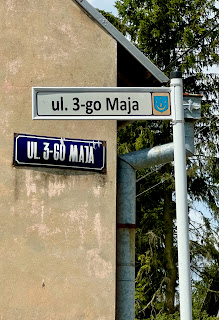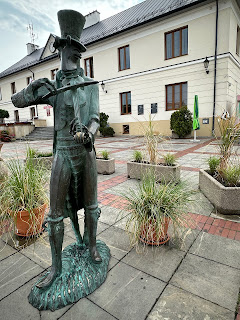Direction sign on our visit to the Braufenbrener and Waldman
ancestral homes
My cousin Beth thinks it is very funny that I cannot pronounce the name of the town.
Determination and help from volunteers from Jewish Records Indexing (JRI) Poland lead to the discovery of his birth and death records, although no information about the murder. His name was Mosze Chill Bronfenbrener (spellings of our last name varied on different documents. Mosze, which is also my father's name, was born in 1900 and died on November 13, 1910 in Frampol. Frampol was the birth place of my great grandmother, my namesake -- Feige (Fanny) Waldman. We assume that after my great grandfather left for the U.S. the family moved in with Feige's mother and father, Gerszko and Gena Waldman. It was believed at the time that boys needed a role model, so Mosze was sent to live with an uncle, although we do not know who that uncle was. Beth and I decided we would go to Poland -- to Frampol and Szczebzreszyn to pay our respects to the family who saved us from certain annihilation 30 years later.
Our first stop in searching for the Braufenbreners was Frampol, a town made a bit famous with a story by Isaac Bashevis Singer, "A Tale of Three Wishes." It is also known for being the town that Hitler chose to practice bombing starting on September 13, 1939. Frampol was chosen for ariel bombing because it was in the shape of a square target. 90% of the town was obliterated, so most everything we saw was built after the war.
Town sign explaining the bombing of Frampol
We had a wonderful driver, Piotr, and he helped us when we first visited the Frampol government office. Unfortunately, our visit was unproductive. Records are not digitized and all records over 100 years old are sent to the office in Zamosc. We didn't have time to visit this larger city which is the capital of the area, but I got an email address to follow up. I had been able to find the name of the street where the Waldman family lived -- 3 Maya. It turned out to b a very short street that begins at the market square and ends at a Catholic church. Beth and I took a walk up and down the street knowing that we were walking in the same steps as our family. There were a couple of houses that looked old, and despite knowing that the town was bombed, we wondered if our family could have lived in one of them.
3 Maya ul. (street)
On the street where they lived
Could they have lived here?
Or here? (Most likely not since most houses do not go back to the 19th century.)
Roman Catholic Church of John of Nepomuk and Our Lady of the Seapular
Beth and I assume that Mosze is buried in Frampol with his mother's family since that is where his death announcement was made. Our last stop in Frampol was the Jewish cemetery. We knew that most of the cemeteries had either deteriorated over time or were destroyed in the war or, later, by the Soviets. Only a few matzevot remained, and none of them belonged to any member of our family whose names include Atzenberg (Fanny's in-laws), Elbaum (Fanny's grandmother), Brezel (Fanny's mother's family), and Radler (Fanny's great grandmother's family). There is a mass burial area where Frampol Jews were shot and buried in mass pits. That area is cordoned off, and there is a small memorial.
Entrance to the Jewish Cemetery
One of the few matzevot
One of the few surviving matzevot
Mass graves from the Holocaust in Frampol
A panoramic view of the cemetery
There was only one restaurant in Frampol, so we had some pizza at the local pizzeria and met our driver, Piotr, to make the way to Szczebrzeszyn. As we got closer we were looking for the sign for the town, one we had seen multiple times on social media and online, but it had been updated like the one for Frampol, and we missed it, so here is the original from a photo I found online.
Na Talandy, our home for two nights
Cmentary Street (Cemetery Street)
Unlike Frampol, most of the houses date back to the end of the 19th century
Could they have lived here (minus the satellite dish)?
Szczebrzeszyn has become an artist's village with several local painters, including some renown artists. One of the local painters, Piotr Koldozidcyk, paints scenes from the town as a shtetl. Many of his painting comes from the memories presented in the book, Tales from the Shtetl, by a local Jewish resident who immigrated about the same time as my family, Philip Bibel.
Szczebrzreszyn became famous when a poet, Jan Brechzwa, wrote a tongue-twister of a poem about a beetle (chrasczc): "W Szczebrzesynie chrzasszc brzmi w trzcine" or "in Szczebrzesyn, a beetle buzzes in the reed." The beetle has become the symbol of the town and is celebrated throughout the town including a statue in front of the town hall.
Chrascz in front of the old synagogue, now the cultural center
Beetle and cricket bench in front of city hall
The beetle made famous by Jan Brechzwa
The Dawna Synagogue was turned into a cultural center, but the city restored some of the interior has been restored. The room is used as an exhibit hall. When the rooftop and bimah of the former Gwozdziec synagogue was being painted for its installation at the Polin Museum, the panels traveled to four towns, involving students from Poland as well as other international students in its creation. The synagogue in Szczebzreszyn was one of those towns.
The lighter-colored parts are original to the synagogue.
The arch and steps are original.
Monica introduced us to a friend who is a retired history teacher in town who is involved in helping people find local ancestors. She also worked with a group of students from Szczebzreszyn and Israel in cleaning up some of the Jewish Cemetery a few years ago. She met with us and, as we walked up the street to the cemetery (it was only yards from where we were staying) she told us the horrors of the day the Jews were all rounded up and walked up that street to the cemetery and murdered. Mothers, fathers, and children were forced to undress and stand waiting for their turn to be shot.
Entrance to the Jewish Cemetery
A few remaining tombstones lying near the entrance
The original school, now the education center
Again, we tried to imagine the house where the Braufenbreners lived
The exterior of the former synagogue
Originally the market square, the plaza now sits in front of the Town Hall.
A photograph of Market Square taken around the turn of the 20th Century
Notice that most of the buildings across the street are the same.
Our amazing journey ended with an emotional goodbye to our host, Monica. But that was after a little trouble with a coffee pot that was not familiar to me, and I did everything wrong. I put the coffee where the water should go. I put the water where nothing should have gone. I turned the induction stove on high when it should have been low. Soon after the kitchen was filled with smoke and everything smelled like burned coffee. Monica was most gracious about my narishkeyt (stupidity).
















.jpeg)
















No comments:
Post a Comment